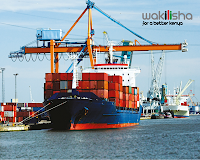Lapsset: The biggest business venture in east Africa
 |
| Artist's impression of Lamu Port |
The venture Comprises thousands of kilometers of
Highway. Railways and oil Pipelines, three resort cities, a seaport with 32
berths, and two International Airports. According
to its feasibility study, the project is to be undertaken on a Private- Public Partnership
(PPP) basis. The consultants, Japan Port Consultants, estimate that the corridor will cost US$23
billion.
There is something for everyone in the project for every
sector is involved. According to an analysis by Kenya’s Ministry of Transport,
Lapsset comprises; 1,710 KM of standard Gauge railway line, 880 KM of a standard
highway, 1260 KM of a crude oil pipeline, 980KM of white oils pipeline, a 120,000
BPD refinery, 32 berths of a seaport covering a 9km area among others.
There are three resort cities whose major goal is to
increase tourism in the arid but high potential lands. The cities, to be driven
by the Tourism Ministry, are Lamu, Isiolo, and Turkana resort cities. Already Isiolo city, to be built at Kipsing
Gap, has been Okayed by the local authorities. It will cost some US$220
million. The construction of the US$12 million Isiolo international airport is
ongoing.
Lamu resort city
and the International Airport, it is expected, will take off together with the
Port and other facilities. It is also expected that with the Discovery of Oil
in Turkana, the Resort city here too has an added advantage.
Although components of the project could be developed on a PPP basis, a majority of the components, it seems, will be developed by the Kenya government together with its partners in the east. Even the consultant has
recommended that the venture would be viable if the private sector were to lease
the infrastructure from the government, rather than participate in building
them.
This creates room
for development partners in the east to come in. The east is defined to include China,
South Korea, and Japan. The Chinese have shot the first volley. The Chinese
Deputy Minister for Trade, Chen Jian, on a recent visit to the country, said
China would provide Kenya with critical expertise on the project. This,
analysts say, is likely to have Japan sit up. The minister virtually promised funding of Chinese companies to do the work.
A Japanese consultant did the feasibility study, and the
Japanese are also said to be interested in a piece of the Lapsset action. The
country has in the recent past witnessed increased activity between China and
Japan in funding infrastructure projects. The same rivalry could be extended
into Lapsset, say, observers.
Even then, there is plenty of activity on Kenya’s second
transport and economic corridor over the next 20 years or so. Already, the
government has set aside some US$300 million for the construction of the first
three- berths at the Port of Lamu.
The three are; a general cargo berth, a bulk cargo berth, and a container berth. These three will be used to transport material for the
development of the corridor.
The entire port itself will cost an estimated US$3.5
billion. Located on 1000 acres of land at Manda
Bay within Lamu, the Port will
comprise 32 berths three of which will be financed by the Kenya
government. The other 29 will be built on a PPP basis.
A 1,710 KM Railway line from Lamu to Juba in South Sudan
will be constructed at a cost of US$8.1 billion according to Kenya Railways
Corporation, www.krc.co.ke. The feasibility study recommends a lease rate of US$343 Million a year in case of a PPP. The study calculated that the freight cost will be as low as US$0.98 per ton- Kilometre for break bulk; US$0.65 ton- KM for container and US$ 0.131 for bulk cargo.
The line is seen as the beginning of the Equatorial Land
Bridge linking the Port of Lamu on the Indian Ocean to the East to the Port of
Doula in Cameroon on the Atlantic Ocean to the West. Such a link, it is
envisaged, will cut freight travel time by at least two to three weeks and
increase shipping lines’ turn-around times and hence their revenue.
The bulk of the entire cost of the Lamu-Transport corridor
will fall on Kenya .
At the peak of the project, between 2013 and 2018 sources say, it is expected
that the Kenyan government will be spending about 6 percent of the country's
Gross Domestic Product or 16 percent of its annual budget on the project. The
project is in turn expected to generate an additional five percent increase in
Kenya's GDP once operational.
At the time of the feasibility study, oil had not been
discovered in Turkana County. This discovery raises the viability of the
project on Kenya’s economy. Some observers are looking at an EIRR greater than
25 percent. Its contribution to Kenya's GDP will be even higher than the projected five percent.
Related Stories http://eaers.blogspot.com/2012/02/kenya-to-begin-construction-of-gateway.html
http://eaers.blogspot.com/2012/04/awaiting-birth-energy-cities-in-kenyas.html
Related Stories http://eaers.blogspot.com/2012/02/kenya-to-begin-construction-of-gateway.html
http://eaers.blogspot.com/2012/04/awaiting-birth-energy-cities-in-kenyas.html



Comments
Post a Comment